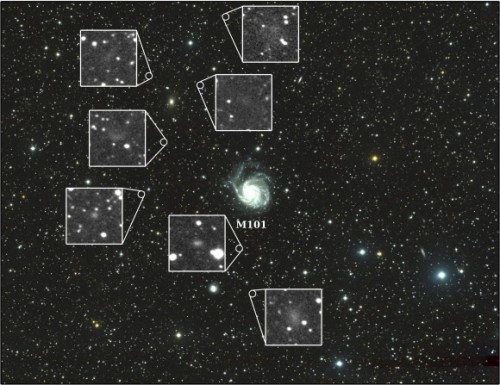
(The seven galaxies pictured surrounding the Pinwheel Galaxy – Photo Credit: Yale University)
Using a new, unique type of telescope, Yale University astronomers have discovered seven dwarf galaxies that surround M101, the well-known Pinwheel Galaxy. The previously unknown galaxies could reveal important insights into dark matter and galaxy evolution, while signaling the discovery of a new class of cosmic objects.
This discovery was quick, “We got an exciting result in our first images,” announced Allison Merritt, lead author of a paper about the discovery. “It was very exciting. It speaks to the quality of the telescope.”
It’s unclear if the seven galaxies are orbiting the Pinwheel Galaxy, or if they just happen to be located in the same field of view. However astronomers at Yale state that this discovery proves that the telescope is working, and the team are now planning follow-up observations to see what other celestial objects they can uncover.
Pieter van Dokkum, chair of Yale’s astronomy department, designed the robotic telescope with University of Toronto astronomer Roberto Abraham. The duo built the compact telescope in 2012 and gave it it’s unique name, the Dragonfly Telephoto Array, as the lenses resemble the compound eye of an insect.
The telescope uses eight specially coated telephoto lenses that suppress internally scattered light. This makes the telescope uniquely capable to detect the very low surface brightness of the newly discovered galaxies.
“These are the same kind of lenses that are used in sporting events like the World Cup. We decided to point them upward instead,” explained van Dokkum. “We knew there was a whole set of science questions that could be answered if we could see diffuse objects in the sky…It’s a new domain. We’re exploring a region of parameter space that had not been explored before,” van Dokkum added.
The team’s next project will attempt to understand whether these newly found dwarf galaxies are orbiting around the M101 spiral galaxy, or are instead located much closer or farther away and are, just by chance, visible in the same direction as M101.
If it’s the latter, Merritt believes that these objects represent something entirely different. “There are predictions from galaxy formation theory about the need for a population of very diffuse, isolated galaxies in the universe,” Merritt stated. “It may be that these seven galaxies are the tip of the iceberg, and there are thousands of them in the sky that we haven’t detected yet.”
Until they collect more data and determine the distance between the dwarf galaxies and the spiral galaxy, researchers won’t know their true nature. However, the possibilities of this study are intriguing enough that the team has been granted the rare opportunity to use the Hubble Space Telescope for further study.
“I’m confident that some of them will turn out to be a new class of objects,” van Dokkum said. “I’d be surprised if all seven of them are satellites of M101.”
In the mean time, more work has been lined up for the new telescope. In addition to discovering new galaxies, the team is also looking for debris from long-ago galaxy collisions. “We are collecting new data with the Dragonfly telescope every clear night. We’re all curious to see what other surprises the night sky has in store for us,” Merritt announced.